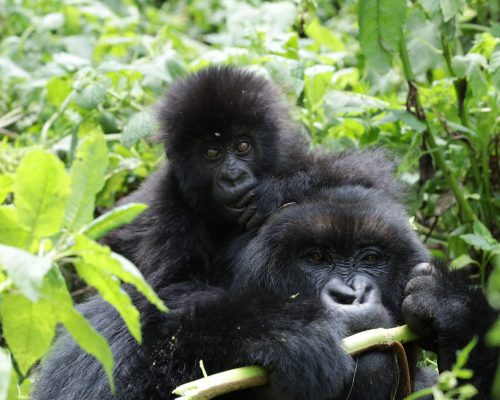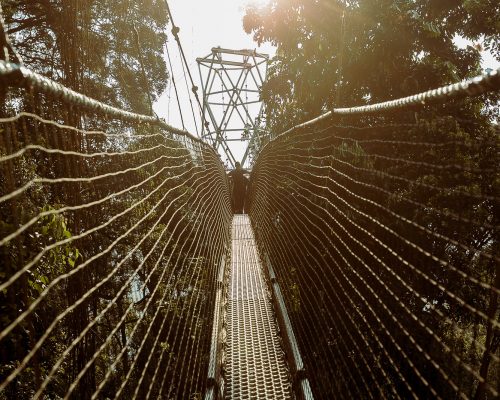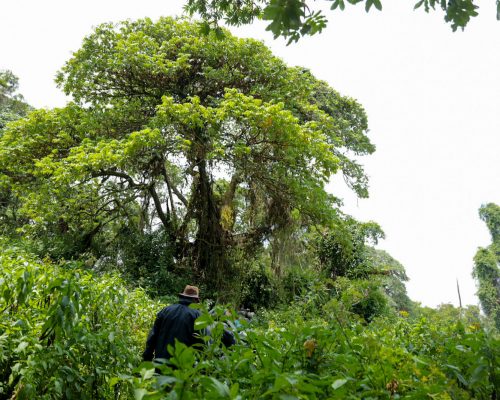Visit Rwanda National Parks with Verdant Safaris and be sure to have the most memorable adventure as you explore this remarkable land of a thousand hills. Rwanda is a very popular tourist destination in East Africa is one of the few places that you can find mountain gorillas in their natural habitat, in Volcanoes National Park which is is one of the most visited tourist destinations in Rwanda. Tourists to Rwanda also like to explore wildlife in Akagera National Park that also presents opportunities of boat rides along Lake Ihema for more unique sightings. Nyungwe Forest National Park is famous for chimpanzee tracking safaris in Rwanda and as well as the canopy walk experience that grants you panoramic views of this dense forest. Our Rwanda Safaris and wildlife tours are well planned to take you to fully explore Rwanda National Parks and so much more.
Your Guide to the Land of a Thousand Hills
Rwanda offers some of Africa’s most spectacular national parks and wildlife experiences. This comprehensive guide explores Rwanda’s three magnificent national parks, each offering unique attractions, activities, and unforgettable encounters with nature. From mountain gorillas to golden monkeys, from savanna wildlife to pristine lakes, Rwanda’s national parks provide world-class safari experiences in one of Africa’s most beautiful and well-managed destinations.
Volcanoes National Park: Home of the Mountain Gorillas
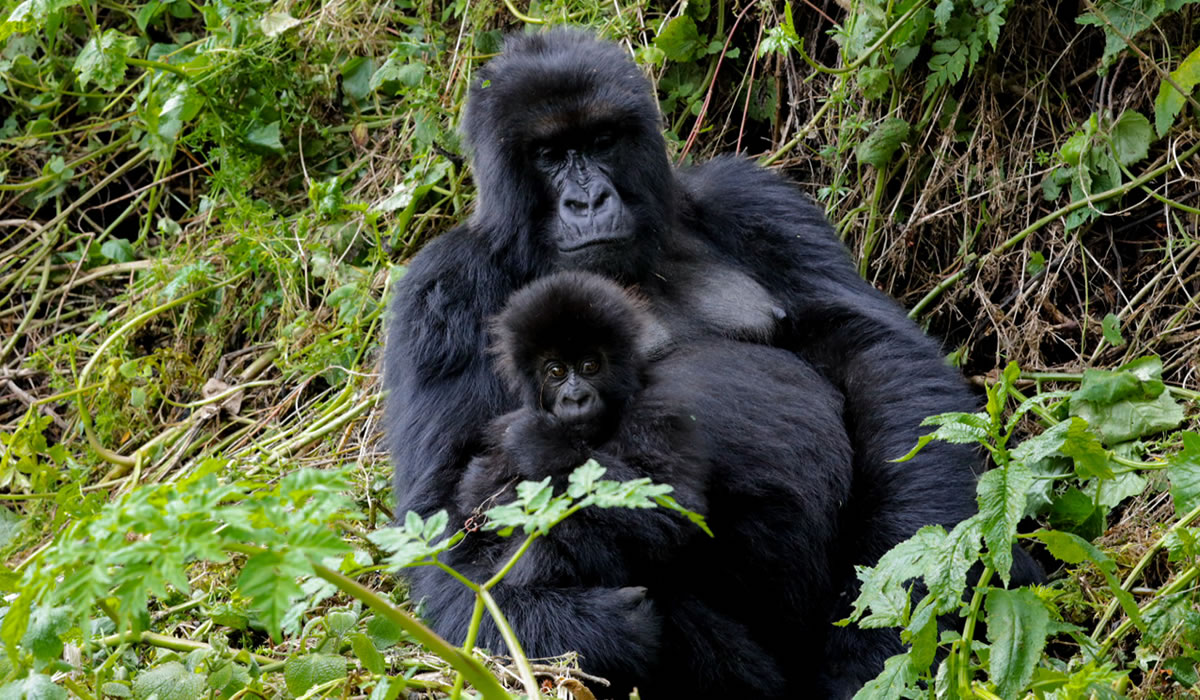
Volcanoes National Park, located in northwestern Rwanda, stands as the country’s most famous and visited national park. This 160-square-kilometer park forms part of the larger Virunga Conservation Area, spanning across Rwanda, Uganda, and the Democratic Republic of Congo. The park’s primary attraction is mountain gorilla trekking, one of the world’s most sought-after wildlife experiences.
The park is home to approximately 400 mountain gorillas, with 12 habituated gorilla families available for tourist visits. Gorilla trekking in Volcanoes National Park offers visitors the rare opportunity to spend one hour observing these magnificent creatures in their natural habitat. The experience begins with an early morning briefing at the park headquarters in Kinigi, followed by guided treks through bamboo forests and volcanic slopes to locate the gorilla families.
Beyond gorilla trekking, Volcanoes National Park offers golden monkey tracking, another primate experience that allows visitors to observe these endangered and playful primates endemic to the Virunga Mountains. The park also features volcano hiking opportunities, with Mount Karisimbi and Mount Bisoke being popular choices for adventurous travelers. Mount Karisimbi, standing at 4,507 meters, is Rwanda’s highest peak and offers challenging two-day hiking experiences with overnight camping.
Cultural experiences near Volcanoes National Park include visits to the Iby’Iwacu Cultural Village, where visitors can learn about traditional Rwandan culture, participate in traditional ceremonies, and interact with local communities. The Ellen DeGeneres Campus of the Dian Fossey Gorilla Fund provides educational opportunities about gorilla conservation and research.
Nyungwe National Park: Primate Paradise and Canopy Adventures
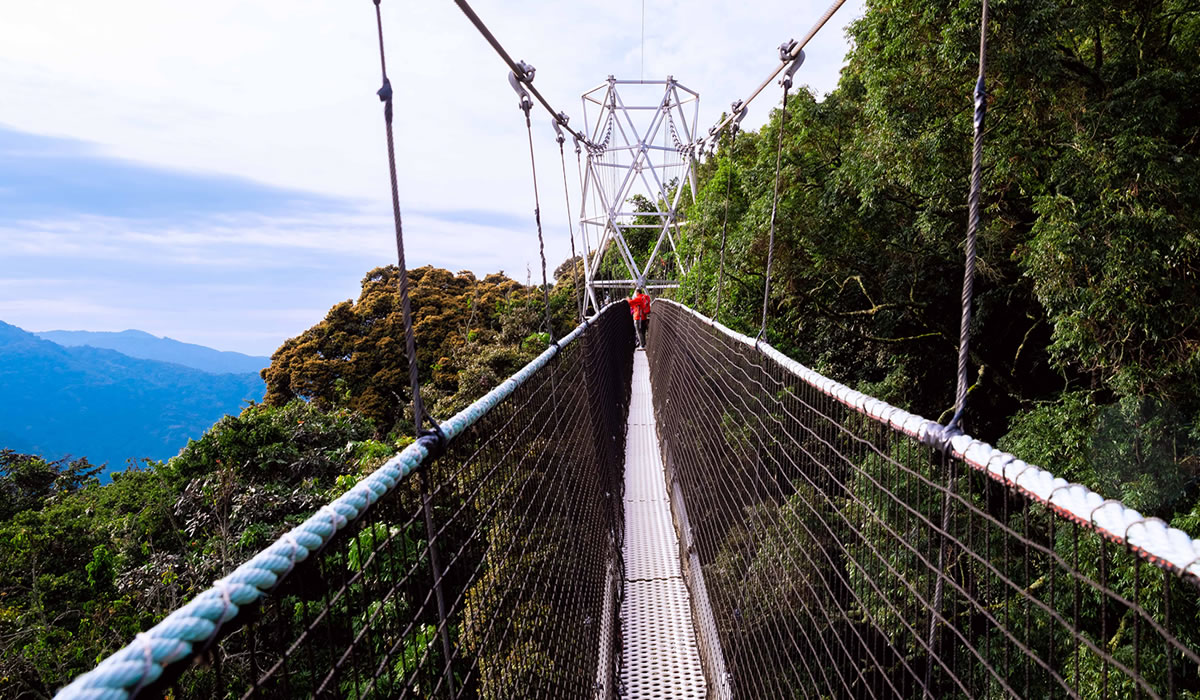
Nyungwe National Park, located in southwestern Rwanda, encompasses one of Africa’s oldest and most biodiverse montane rainforests. Covering 1,019 square kilometers, this UNESCO World Heritage site candidate hosts 13 primate species, including chimpanzees, making it one of the most important primate conservation areas in Africa.
Chimpanzee trekking in Nyungwe National Park offers visitors the chance to observe these intelligent primates in their natural forest habitat. The park is home to over 400 chimpanzees, with several habituated groups available for tourist visits. Guided chimpanzee tracking excursions typically last between two to six hours, depending on the location of the chimpanzee communities.
The park’s famous canopy walkway, suspended 50 meters above the forest floor, provides a unique perspective of the rainforest ecosystem. This 160-meter-long walkway allows visitors to observe the forest canopy, spot various bird species, and experience the rainforest from a completely different vantage point. The canopy walk has become one of Rwanda’s most popular tourist activities, offering photographers and nature enthusiasts exceptional opportunities.
Nyungwe National Park is a birder’s paradise, hosting over 310 bird species, including 27 Albertine Rift endemics. The park’s diverse ecosystems support species such as the Rwenzori turaco, red-collared babbler, and various sunbird species. Guided bird watching tours are available throughout the park, with early morning being the optimal time for bird observation.
Nature walks and hiking trails in Nyungwe cater to different fitness levels and interests. The Igishigishigi Trail leads to beautiful waterfalls, while the Karamba Birding Trail offers excellent bird watching opportunities. The Source of the Nile Trail takes visitors to one of the farthest sources of the Nile River, providing both natural beauty and historical significance.
Akagera National Park: Big Five Safari Experience
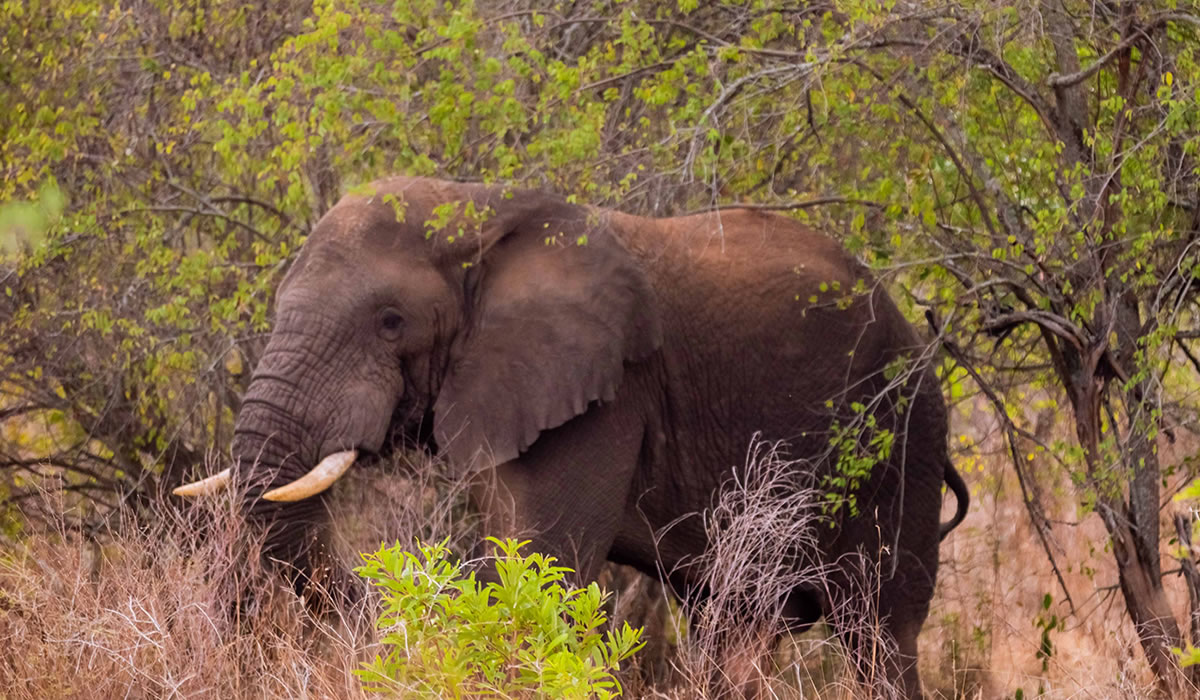
Akagera National Park, located in eastern Rwanda along the Tanzanian border, represents Rwanda’s only savanna ecosystem and Big Five safari destination. Covering 1,122 square kilometers, the park encompasses diverse habitats including savanna plains, woodlands, wetlands, and lakes, creating ideal conditions for diverse wildlife populations.
The park’s successful conservation story includes the reintroduction of lions in 2015 and black rhinos in 2017, making Akagera one of the few places in Rwanda where visitors can potentially spot the Big Five: lions, leopards, elephants, buffalo, and rhinos. Game drives in Akagera offer excellent wildlife viewing opportunities, with the best times being early morning and late afternoon when animals are most active.
Akagera National Park is home to over 8,000 large mammals, including elephants, buffalos, zebras, giraffes, hippos, crocodiles, and various antelope species. The park’s predator population includes lions, leopards, hyenas, and various smaller carnivores. The successful lion reintroduction program has resulted in a growing pride population, making lion sightings increasingly common.
Lake Ihema, the park’s largest lake, provides excellent opportunities for boat safaris and fishing excursions. Boat trips on Lake Ihema offer unique perspectives of hippos, crocodiles, and numerous water birds, including the rare shoebill stork. The lake’s shores attract various wildlife species, making it an excellent location for wildlife photography and observation.
Bird watching in Akagera is exceptional, with over 480 bird species recorded in the park. The diverse habitats support species ranging from water birds around the lakes to forest species in the woodland areas. Notable species include the shoebill stork, African fish eagle, lilac-breasted roller, and various raptor species.
Gishwati-Mukura National Park: Rwanda’s Newest Conservation Gem
Gishwati-Mukura National Park is the newest addition to Rwanda’s network of protected areas, established in 2015 to conserve two fragmented forests, Gishwati and Mukura. Located along the Albertine Rift, the park spans over 34 square kilometers and is part of Rwanda’s effort to reforest and restore critical habitats.
Though smaller and less visited than other parks, Gishwati-Mukura offers a more intimate and less commercialized experience. It is home to four primate species including chimpanzees, golden monkeys, blue monkeys and L’Hoest’s monkeys. Guided nature walks and primate tracking are the main activities here, and the park is also a budding destination for birdwatching, with over 200 species recorded.
The park has a strong emphasis on community-based conservation, and visitors can engage in cultural tours, visit local cooperatives or participate in tree planting activities. These experiences not only support local communities but also enhance conservation efforts.
Accommodation options are still developing around Gishwati-Mukura, but nearby cities like Rubavu offer hotels and guesthouses. Plans are underway for eco-lodges and sustainable tourism infrastructure, making it a promising destination for future eco-tourism.
The best time to visit Gishwati-Mukura National Park is during the dry months from June to September and December to February. This ensures easier forest access and better chances for primate sightings and birdwatching.
Accommodation Options Across Rwanda’s National Parks
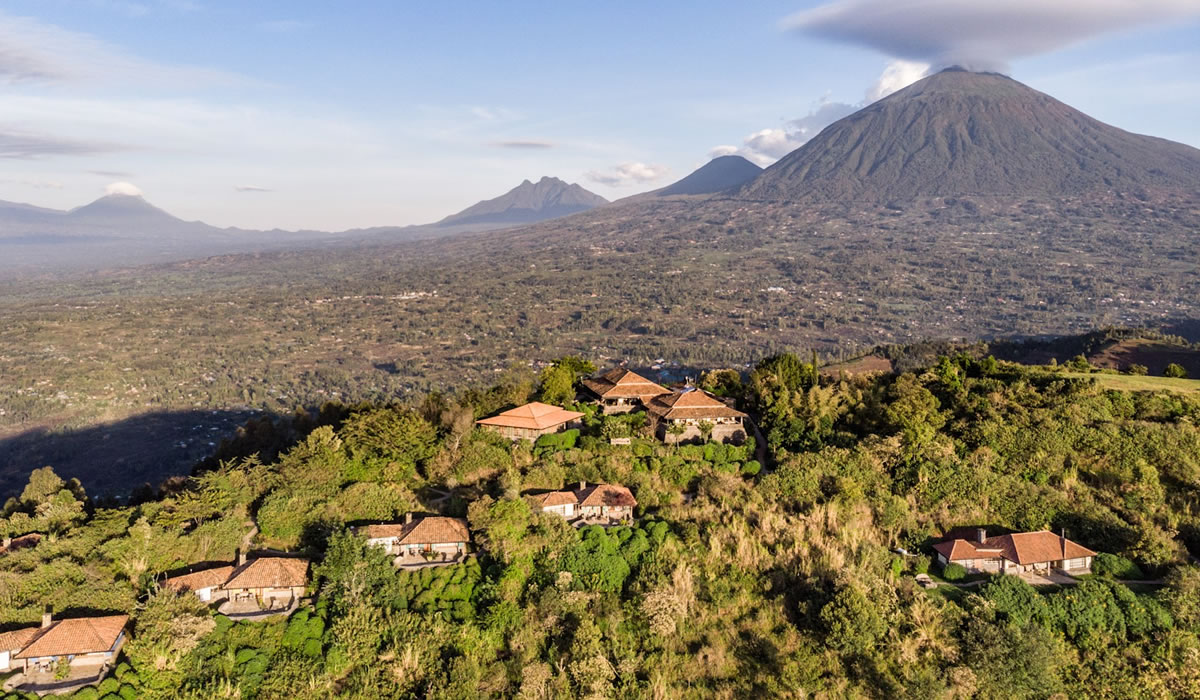
Rwanda offers diverse accommodation options near its national parks, ranging from luxury lodges to budget-friendly guesthouses. Near Volcanoes National Park, luxury options include Bisate Lodge, Sabyinyo Silverback Lodge, and Virunga Lodge, all offering exceptional service and stunning mountain views. Mid-range options include Mountain Gorilla View Lodge and Hotel Muhabura, while budget travelers can choose from various guesthouses in Musanze town.
For Nyungwe National Park, Nyungwe House provides luxury accommodation within the park boundaries, offering easy access to park activities. One&Only Nyungwe House delivers ultra-luxury experiences with spa services and gourmet dining. Mid-range options include Nyungwe Top View Hotel and various lodges in nearby Huye town, while budget accommodations are available in local towns surrounding the park.
Akagera National Park offers unique accommodation experiences, including Magashi Camp, a luxury tented camp offering all-inclusive safari packages. Ruzizi Tented Lodge provides mid-range accommodation with comfortable tents and excellent service. The park also features designated camping sites for budget travelers who prefer outdoor experiences under the African sky.
Best Time to Visit Rwanda National Parks
Rwanda’s equatorial climate provides year-round travel opportunities, but certain seasons offer optimal conditions for specific activities. The dry seasons, from June to September and December to February, are generally considered the best times for gorilla trekking and wildlife viewing. During these periods, trails are less muddy, vegetation is less dense, and wildlife congregates around water sources.
The wet seasons, from March to May and October to November, bring lush green landscapes and excellent bird watching opportunities as migratory species arrive. While hiking can be more challenging during wet seasons, the dramatic scenery and fewer crowds make this period attractive for some travelers. Photography enthusiasts often prefer the wet season for capturing the vibrant green landscapes and dramatic cloud formations.
For gorilla trekking specifically, the dry months offer easier hiking conditions, but gorilla permits are available year-round, and the experience remains exceptional regardless of the season. Chimpanzee trekking in Nyungwe is excellent throughout the year, though the dry season provides easier forest navigation.
Planning Your Rwanda National Parks Adventure
Rwanda’s national parks offer world-class wildlife experiences in a compact, easily accessible country. Gorilla permits for Volcanoes National Park cost $1,500 per person and should be booked well in advance, especially during peak seasons. Chimpanzee permits for Nyungwe cost $150 per person, while Akagera National Park charges daily entrance fees.
Most visitors combine multiple parks in a single trip, with Verdant Safaris offering comprehensive packages covering all three parks. The country’s excellent road infrastructure makes park-to-park travel convenient, with most destinations accessible within a few hours’ drive from Kigali, the capital city.
Rwanda’s commitment to conservation and sustainable tourism ensures that visiting these national parks contributes directly to wildlife protection and local community development. The country’s remarkable recovery and development over the past decades has created a safe, clean, and welcoming destination for international travelers seeking authentic African wildlife experiences.
Whether you’re seeking the thrill of gorilla encounters, the adventure of chimpanzee trekking, or the excitement of Big Five safaris, Rwanda’s national parks deliver unforgettable experiences in some of Africa’s most spectacular natural settings.



